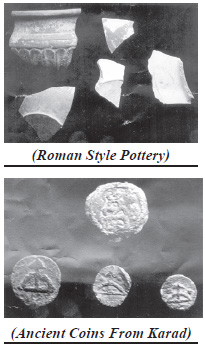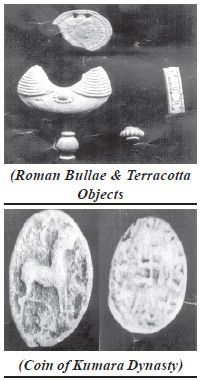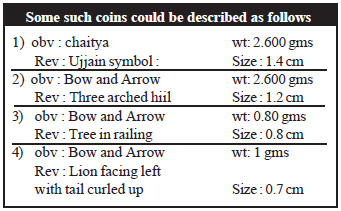Exploration at Karad
By Sanjay
Godbole
'Karad' is
one of the important cities and centers in the
district of 'Satara* in Maharashtra. 'Karad' is
situated 17° 17' N. Latitude and 74° 13'
Longitude and lies in the valley of rivers
Krishna and Koyna. Karad has been assuming
importance centuries after centuries on account
of several unique features and specialties. We
also get stray references from the chronicles of
ancient history as to how this place got to
acquire it's present name "karad'. There is a
place called 'Bharuth' near 'Jabalpur'. In the
inscription surfacing at the stupa at Bharuth [
2n Century B.C.] a mention has been made, of the
donations given by the ' Bhikku sangham'
[Confederation of Bhikkhus] of Karad. This
mention refers to "karad' as 'Karahakat'. There
are rock cut caves at "kuda' near "Alibaug'. At'
Kuda' Karad has since been referred to as 'Karhakad'.
The oldest available remains in the precincts of
Karad are the Buddhist rock cut caves at "Agashiva'.
These rock cut caves belong to Hinayana sect.
There is an inscription in these rock cut caves
stating that these caves were donated to the
Bhikkhu Sangham by 'sanghamitra'. Some
archaeological experts are of the opinion that
looking to the style of the rock cut cave and
the Sculpture and the monasaries in them this
rock cut cave belonging to Hinayana Sect must
belong to the second century.

In the area
surrounding Karad many remains frequently
surface. These remains are mostly in the form of
terracotta's, ancient coins, beads and
potsherds. The Royal Asiatic society has taken a
due congnizance of the remains surfacing in this
area. In the rainy season, all rivers are in
spate. After the spate water is over, numerous
ancient coins are found. Previously, all such
coins were deposited with the District
collectorate at Satara.
The Asiatic
society has made a special mention that majority
of these and such coins belong to the western
Kshatraps. The Bharat Itihas Sanshodhak Mandal
of Pune has a Lion's share in surfacing the
various remains found near Karad. The Bharat
Itihas Sanshodhak Mandal, Pune, has brought to
light a very ancient Jain idol. Bharat Itihas
Sanshodhak Mandal, Pune initiated an excavation
project at an ancient hillock near the ramparts
(of a fort) called (pant Kot) in the year 1948
at Karad. During this excavation, the following
articles surfaced, belonging to Satavahana
period Ring-wells, dishes, utensils, earthen
pots, Roman styled potsherds and Chinese Celedon
type wares & utensils. In addition to these,
Satavahana period pedestals, ivory sticks for
eye make-up i.e. application of Lamp black (Kajal),
terracottas & coins were also surfaced. The
research scholars of Bharat Itihas Sanshodhak
Mandal and Shri. Y.R. Gupte, the Assistant
director Epigraphy Karad also has published a
detailed report as to the history of Karad. Shri.
B.M. Purandare, has found a Roman bullae from
the area surrounding Karad, Mr. G.H. Khare
Praised Shri. Purandare on this count.
Even as on
today, the area around Karad abounds in ancient
coins. Majority of these coins are struck in Lead. On
obverse of these coins, an image of a Lion and
on the reverse a symbol of an arrow and a bow
are depicted. These coins invariably make a
reference to the 'Kumara' dynasty, and have been
brought to light from this area. It is from this
very area an important coin from numismatic
point of view has been brought to light. This
coin weighed 3.200 gms, was oblong in shape and
was made of Lead. On the obverse side, there is
a motif of a Lion; and on the reverse side there
are letters reading as 'Maha Senapati Kumaras'
in the Brahmi Script around the Swastika symbol.
While studying the pattern and the type of this
coin one is sure to remember the Swastika type
coins struck by Mahasenapati Manamahisha of
Kondapur in Andhra Pradesh. I published an
exhaustive note of that coin in the newsletter
(May 1997) of the Oriental Numismatic Society.
It was at this site only that the famous
oriental scholar, Shri Bhandarkar came across a
copper-plate belonging to 'King Krishna' the
third of (he Rashtrakuta Dynasty. This copper
plate refers to Karad as 'Karhat'. At Karad, one
comes across many remains belonging to the
Muhamedian regimes of medieval times. A majority
of those remains belong to the Adilshahi period
or times. The deputy chief of the Bijapur court
was stationed at Karad at that time. Those,
desirous of undertaking the Haj pilgrimage
traditionally went to Dabhol harbour via karad
in those times. An entry gate situated in the
north of Karad was called the 'Dabhol' gate.
There is also a large sized well, in the west of
Karad, said to belong to Adilshahi period. In
the surrounding area one sees the remains of the
embankments of an old water storage tank.
Majority of these coins are struck in Lead. On
obverse of these coins, an image of a Lion and
on the reverse a symbol of an arrow and a bow
are depicted. These coins invariably make a
reference to the 'Kumara' dynasty, and have been
brought to light from this area. It is from this
very area an important coin from numismatic
point of view has been brought to light. This
coin weighed 3.200 gms, was oblong in shape and
was made of Lead. On the obverse side, there is
a motif of a Lion; and on the reverse side there
are letters reading as 'Maha Senapati Kumaras'
in the Brahmi Script around the Swastika symbol.
While studying the pattern and the type of this
coin one is sure to remember the Swastika type
coins struck by Mahasenapati Manamahisha of
Kondapur in Andhra Pradesh. I published an
exhaustive note of that coin in the newsletter
(May 1997) of the Oriental Numismatic Society.
It was at this site only that the famous
oriental scholar, Shri Bhandarkar came across a
copper-plate belonging to 'King Krishna' the
third of (he Rashtrakuta Dynasty. This copper
plate refers to Karad as 'Karhat'. At Karad, one
comes across many remains belonging to the
Muhamedian regimes of medieval times. A majority
of those remains belong to the Adilshahi period
or times. The deputy chief of the Bijapur court
was stationed at Karad at that time. Those,
desirous of undertaking the Haj pilgrimage
traditionally went to Dabhol harbour via karad
in those times. An entry gate situated in the
north of Karad was called the 'Dabhol' gate.
There is also a large sized well, in the west of
Karad, said to belong to Adilshahi period. In
the surrounding area one sees the remains of the
embankments of an old water storage tank.
There are two
Dargas built in 1350 AD & 1391 A.D. in Guruwar
peth at Karad. [Peth is an area identified in
the name of a week day.] One of these Dargahs is
having considerable height. There is also an old
monument in Shaniwar peth in karad, known as
Khwaja Khizar Dargah'. Most of the Dargahs do
have sanctioned annual gifts or gratuities since
the times of Adilshahi regimes. The most
picturesque and attractive Building in Karad
happens to be the mosque built by Ibrahim khan
between the year 1557 A.D. & 1580 A.D. during
the regime of Ali Adilshah the first. There are
imposingly magnificent minarets 106 ft. high by
the side of this mosque. A legend is making
rounds in 1659, here that fazal Khan, the son of
Afzal Khan after he [ Afzal Khan] was slain,
went into hiding in these minarets. Rooms and
baths are built in the precincts of this mosque
for convenience of the pilgrims. There is a
specific reference in the stone inscription that
the above work of construction, was completed in
the year 1580 A.D. [Year 983 as per Hijari
calender]

One can obtain
a sight of these Minarets from at a distance.
With a view to make an indepth study of this
structure, I went inside the minarets, after
obtaining the necessary permission from the
authorities. The steps inside the Minaret were
built instone and the tread and rise were
abnormally wide & high. The diameter ( inner
one) of the minar was like a room, according to
my estimate. 1 could also have a close look at
the stone inscription detailing the
establishment of the foundation of this mosque.
The inscription of this Adilshahi mosque was in
Persian. During the tenure of my mission of
exploration at Karad, I tried very extensively,
to know whether any Persian documents or
manuscripts could be made available to me. I
learned that some gentleman at Karad was in
possession of a collection of Persian verses. I
however, could not contact him at that time. All
the same, I could see an incomplete manuscript
of ' Sheikh Saadi's' poems of Mughal period
called 'Gulistan'.
There is an
ancient 'Eid gah' meeting ground during 'Eid' at
Karad [Eid- gah a meeting ground for offering
Namaz prayers for a large congregation] It is
250 feet long and it's construction was
completed during the year 1577 A.D. [ Year 980
as per Hijari Calender]
Between the
years 1992 - 1995, A.D. I myself and one of my
friends (late) Shri Shrikant Sahastrabuddhe went
to Karad, in search of ancient remains. There
was one Mr. Gharge, a local resident of Karad
who was a collector and compiler of such old and
rare and historically precious items and had
made a sizable collection of sculptures. We saw
Mr. Gharge's entire collection preserved in a
local school. Had some one cared to take out a
small handbook or brochure giving informative
details of all the antiquities, it would have
gone a long way to help the students of ancient
hisotory & art in systematically studying the
same.
During our
study tour of Karad we frequently visited the
scrap dealers and goldsmiths & jewelers and many
times we could discover ancient coins or old
brass wares or copperwares. Majority of coins
surfaced at Karad belonged to medieval sultans
[Such as from, Adilshahi, Bahmani & Nizamshahi
sultans]. In some of the instances, the coin
chronology dated back straight to Satavahana
Period. At Karad, numerous coins have surfaced
belonging to 'Ashmak'. At Karad mainly the coins
belonging to "kumara Dynasty' who were tributory
to "Satavahana have surfaced. One such coin has
since been described earlier. At Karad many
'Lead' coins were available which were mostly
associated with or pertinently related to
Satavahana and / or Kumara dynesties . On some
of these coins, more importantly, we found that
a symbol consisting of a 'Bow and Arrow' was
depicted, a fact which indicated that these
coins belonged to "Kura' Dynesty.
At Karad, many
a time, terracotta Roman Bullaes are reported
during explorations. Since Roman coins were
famous in the world for their excellent
craftsmanship and artistic form, these Bullaes
were made from the impressions of these coins as
a die - cast- mould. These Bullaes surfacing at
Karade are 2:-- cm in diameter and have two
small apertures pieced in these so that these
could be sported as necklaces.
Numerous
ancient remains such as Roman styled red
polished ware, glass bangles, Terracotta
earrings, potsherds, Roman wares with decorative
motiffs, earthen beads with motif, Bangles made
out of Conch -shells, have surfaced in Karad.
All these must have reached Karad due to
international trading activities.
Gold coins of
later chalukyas in the shape of a horse - shoe
very frequently surfaced in karad, meaning
thereby, that these were in vogue or in
circulation, in those periods.
In addition, Medieval period
earthenware pots and utensils also are found in
the precincts of Karad, though sporadically. On
account of these ancient remains surfaced at
Karad, it is evident that Karad was a prominent
trade centre during ' Satavahana Period'. The
caves belonging to "Hinayana' sect and the
remains of jain idols clearly establish the
significant rapport of people practising jain &
Buddhist faith with the city of "karad". like
the ancient period, the importance of Karad has
not been belittled in any way during Medieval
periods. This Fact is borne out by the presence
of the structures existing and other related
remains surfaced at Karad.
*(The author is a noted
Archeologist, based in Pune)
Source: Kashmir
Sentinel
| 